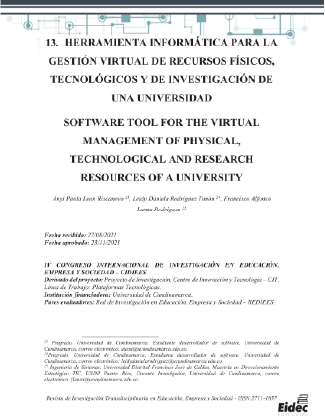XIII. SOFTWARE TOOL FOR THE VIRTUAL MANAGEMENT OF PHYSICAL, TECHNOLOGICAL AND RESEARCH RESOURCES OF A UNIVERSITY
##plugins.themes.bootstrap3.article.main##
Abstract
The present article aims to purpose is to show the design of an IT tool, in a web environ-ment, that allows to collect, process, store and distribute information for the management of physical and technological resources and research resources, providing techno-logical support to the academic programs of the University of Cundinamarca. Because currently, the evidence of these processes is stored in the cloud of the institutional drive of the programs, making it difficult to keep the traceability of processes such as the use of physical and technological resources available to the academic programs of the University, and also the monitoring and control of research processes such as the production of research groups and seedlings, as well as the traceability of participation in scientific and academic events, during the course of the academic period. The design of the software tool is based on an exhaustive study of the state of the art, the use of the IEEE format, according to the 830 standard, for the determination of functional and technical requirements of the software, the implementation of the Unified Modeling Language -UML for the representation of each of the software dimensions such as the Static dimen-sion, the Dynamic dimension and the Functional dimension, and the use of the agile SCRUM methodology for the management of software development in an environment of changing requirements.
Download Statistics
##plugins.themes.bootstrap3.article.details##
Process optimization, Physical and technological resources, Computer systems, IT module, Software


 https://orcid.org/0000-0003-0006-9430
https://orcid.org/0000-0003-0006-9430



